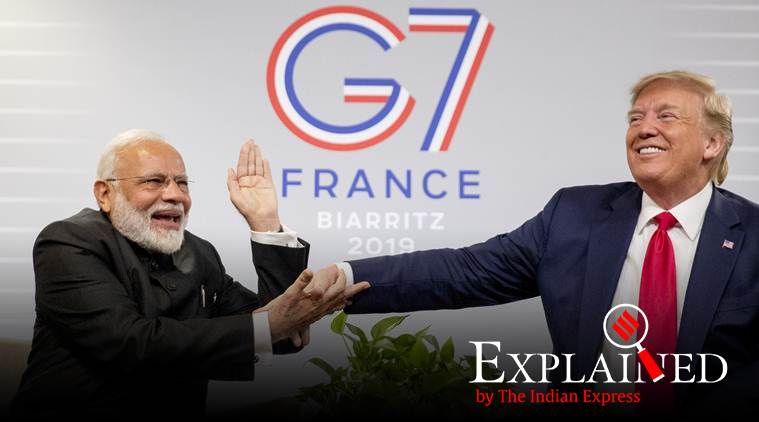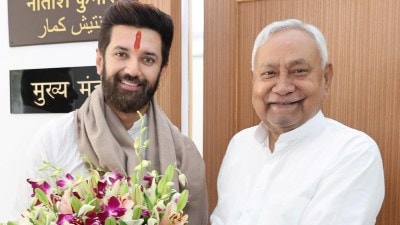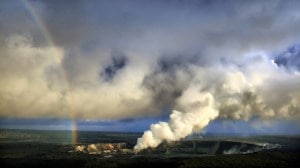Explained: What is the G-7, why is PM Narendra Modi in France right now
The G7 or 'Group of Seven' are Canada, France, Germany, Italy, Japan, the United Kingdom, and the United States. It is an intergovernmental organisation that was formed in 1975 by the top economies of the time as an informal forum to discuss pressing world issues.
 Prime Minister Narendra Modi, left, slaps the hand of US President Donald Trump as they share a laugh during a bilateral meeting at the G-7 summit in Biarritz, France, Monday, Aug. 26, 2019. (AP Photo/Andrew Harnik)
Prime Minister Narendra Modi, left, slaps the hand of US President Donald Trump as they share a laugh during a bilateral meeting at the G-7 summit in Biarritz, France, Monday, Aug. 26, 2019. (AP Photo/Andrew Harnik)
Prime Minister Narendra Modi has met US President Donald Trump on the sidelines of the G7 Summit in Biarritz in southwestern France. Modi was invited to attend the Summit as a special guest of French President Emmanuel Macron.
What is the G7, and why was Prime Minister Modi invited this year?
The Group of 7
The G7 or ‘Group of Seven’ are Canada, France, Germany, Italy, Japan, the United Kingdom, and the United States. It is an intergovernmental organisation that was formed in 1975 by the top economies of the time as an informal forum to discuss pressing world issues.
Canada joined the group in 1976, and the European Union began attending since 1977.
The G7 was known as the ‘G8’ for several years after the original seven were joined by Russia in 1997. The Group returned to being called G7 after Russia was expelled as a member in 2014 following the latter’s annexation of the Crimea region of Ukraine.
 Britain’s Prime Minister Boris Johnson, Canadian Prime Minister Justin Trudeau, German Chancellor Angela Merkel, French President Emmanuel Macron, South African President Cyril Ramaphosa, European Council President Donald Tusk, Italian Prime Minister Giuseppe Conte, Japanese Prime Minister Shinzo Abe and Prime Minister Narendra Modi attend a working lunch with world leaders during the G7 summit in Biarritz, France, August 26, 2019. (Reuters Photo: Dylan Martinez)
Britain’s Prime Minister Boris Johnson, Canadian Prime Minister Justin Trudeau, German Chancellor Angela Merkel, French President Emmanuel Macron, South African President Cyril Ramaphosa, European Council President Donald Tusk, Italian Prime Minister Giuseppe Conte, Japanese Prime Minister Shinzo Abe and Prime Minister Narendra Modi attend a working lunch with world leaders during the G7 summit in Biarritz, France, August 26, 2019. (Reuters Photo: Dylan Martinez)
The G7 nations meet at annual Summits that are presided over by leaders of member countries on a rotational basis.
The current G7 Summit being held in France is the 45th, and the next one will be held in the United States in 2020. The host country typically gets to invite dignitaries from outside the G7 to attend the Summit.
What the G7 does
The G7 Summit is an informal gathering that lasts two days, in which leaders of member countries discuss a wide range of global issues.
The groundwork for the Summit, including matters to be discussed and follow-up meetings, is done by the “sherpas”, who are generally personal representatives or members of diplomatic staff such as ambassadors. The sherpa for Prime Minister Modi at the current Summit is former Union Minister Suresh Prabhu.
The Group was initially formed as an effort by the US and its allies to discuss economic issues, which in the late 1970s included battling a global oil crisis.
 Indian Prime Minister Narendra Modi meets U.S. President Donald Trump (not pictured) for bilateral talks during the G7 summit in Biarritz, France, August 26, 2019. (Reuters Photo: Carlos Barria)
Indian Prime Minister Narendra Modi meets U.S. President Donald Trump (not pictured) for bilateral talks during the G7 summit in Biarritz, France, August 26, 2019. (Reuters Photo: Carlos Barria)
Since then, the G7 has discussed issues affecting every decade, such as financial crises, and has aimed to tackle specific challenges, such as the economic changeover of ex-Soviet bloc nations, terrorism, arms control, and drug trafficking, among others.
The G7 does not have a formal constitution or a fixed headquarters. The decisions taken by leaders during annual Summits are non-binding.
The rise of India, China, and Brazil over the past few decades has reduced the G7’s relevance, whose share in global GDP has now fallen to around 40%.
G7 and G20
The G20 is a larger group of countries, which also includes G7 members. The G20 was formed in 1999, in response to a felt need to bring more countries on board to address global economic concerns.
Apart from the G7 countries, the G20 comprises Argentina, Australia, Brazil, China, India, Indonesia, Mexico, Russia, Saudi Arabia, South Africa, South Korea, and Turkey.
 Biarritz: Prime Minister Narendra Modi interacts with German Chancellor Angela Merkel during a session on Biodiversity, Oceans, Climate, at the G7 Summit in Biarritz, France, Monday, August 26, 2019. (PIB/PTI Photo)
Biarritz: Prime Minister Narendra Modi interacts with German Chancellor Angela Merkel during a session on Biodiversity, Oceans, Climate, at the G7 Summit in Biarritz, France, Monday, August 26, 2019. (PIB/PTI Photo)
Together, the G20 countries make up around 80% of the world’s economy.
As opposed to the G7, which discusses a broad range of issues, deliberations at the G20 are confined to those concerning the global economy and financial markets.
India is slated to host a G20 summit in 2022.
India at the G7 Summit
The invite to India to be a Biarritz Partner and to Prime Minister Modi to be a special guest at the Summit was extended by President Macron keeping in mind the common interests of India and France, such as tackling climate change and the development of renewable energy.
Prime Minister Modi collaborated closely with President Macron’s predecessor, President François Hollande, in the creation of the International Solar Alliance in 2015.
 Biarritz: Prime Minister Narendra Modi with President of the Republic of Senegal, Macky Sall at a meeting on the sidelines of the G7 Summit, in Biarritz, France, Monday, August 26, 2019. (PIB/PTI Photo)
Biarritz: Prime Minister Narendra Modi with President of the Republic of Senegal, Macky Sall at a meeting on the sidelines of the G7 Summit, in Biarritz, France, Monday, August 26, 2019. (PIB/PTI Photo)
Modi addressed sessions on digital transformation and climate change at the Biarritz Summit. His engagements included meetings with US President Donald Trump, UK Prime Minister Boris Johnson, United Nations Secretary-General Antonio Guterres, and President Macky Sall of Senegal.
The Ministry of External Affairs had described the invitation to Modi as a “reflection of the personal chemistry between the two leaders, a demonstration of our deepening strategic partnership and recognition of India as a major economic power”.






- 01
- 02
- 03
- 04
- 05
































